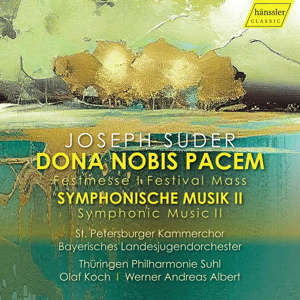
Joseph Suder (1892-1980)
Dona Nobis Pacem – Festival Mass (1946/1947)
Symphonic Music II (1963)
Bayerisches Landesjugendorchester / Werner Andreas Albert (Mass), Thüringen Philharmonie Suhl / Olaf Koch (Symphonic Music)
rec. 1993, Herkulessaal, Munich, Germany (Mass), Philharmonie, Suhl, Germany (Symphonic Music)
Hänssler Classic HC23064 [70]
I was aware of Joseph Suder’s opera Kleide machen Leute (Clothes make the man), which may be his best-known work. He lived a long life, mostly in Munich, where he was active in all musical spheres, perhaps to the detriment of the number of his compositions. Only a few of his works, including the opera he wrote in 1926-1934, are available in retail, but there is more on YouTube, including an old LP of Dona Nobis Pacem.
Suder’s music, quite conservative, often sounds like it would never have offended Bruckner. His individuality lies in the structural concepts, specifically his brand of “synthesis”. There is a snippet about him in the German section of Mark Morris’s Guide to Twentieth Century Composers. Suder’s music is also rather individual in its mixture of polyphonic and harmonic qualities, especially prominent in the Festival Mass.
Dona Nobis Pacem (Grant us peace, the last section of the traditional mass) comes appropriately from right after World War II. The vocal forces are large, but the accompaniment is for chamber orchestra with a big part for the organ. The Kyrie begins sternly, conservative in sound, but with impressive counterpoint, and ends with a beautiful statement of the basic material. The soloists, prominent in the Gloria section, sing in alternation. The chorus provide energetic commentary, and the strings and winds give tone color. The Credo, again built on counterpoint, ends with a massive triple fugue. The organ and a solo violin play important roles, and the children’s choir is effective. I most enjoyed the Sanctus and Benedictus. The former contains wonderful contrasts between the male and female sections of the chorus. The latter comprises a soprano solo accompanied by solo violin and organ. The Agnus Dei naturally emphasizes the last three words “Dona Nobis Pacem”, and is quite moving.
The Symphonic Music II, written almost twenty years later, shows little change in the basic musical language. Suder did not call this piece a symphony: its three sections correspond to the second, third and fourth movements of a traditional symphony, without the opening (often Allegro) movement. There are the same structural features as Dona Nobis Pacem, but without the same emotional effect.
This is a new release of 30-year-old recordings. Both have a dry acoustic, less of a drawback in the Symphonic Music II. The soloists are uniformly excellent, as are the chorus basses, but the rest of the chorus is rather shrill. Werner Andreas Albert gets a big sound from the chamber orchestra in Dona Nobis Pacem, and ably keeps his large forces distinct. Olaf Koch also does a fine job with the Symphonic Music II in a spirited interpretation.
William Kreindler
Help us financially by purchasing from



Other performers – Dona Nobis Pacem
Maria Neilau (alto)
Natalia Kornewa (soprano)
Vladimir Mostovoy (tenor)
Juri Dobrowski (bass)
Marlene Hinterberger (solo violin)
Jessica Hartlieb (organ)
St. Petersburger Kammerchor
Kinderchor des Pestalozzi-Gymnasiums München

















